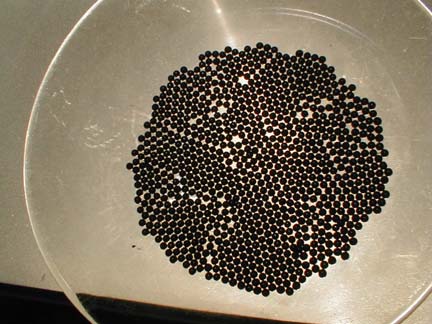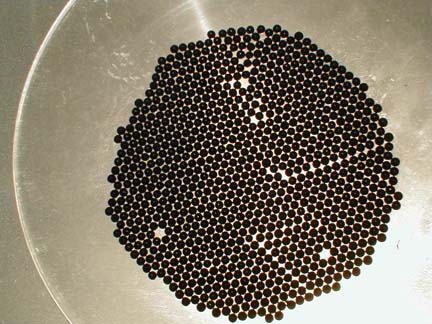Bees do it!

Ball bearings in a bowl start out packing together with many
flaws.
Bees do it!

Ball bearings in a bowl start out packing together with many
flaws.
Material
BBs, many, or small ball bearings 2 mm in
diameter
a plate, 10 cm or more in diameter with a bowl-shaped bottom, a watch
glass is perfect.
a clear plate will allow you to project the pattern on an overhead
projector.
Tweezers or a magnet and a nail
Assembly
Fill the plate with a layer of ball bearings one
layer deep.
Go all the way to the edges and up the edges a little bit. (Gravity
will pull down on the bearings on the raised edges and push the other
balls together.)
To Do and Notice
Notice the pattern of the balls.
Notice local patterns, and changes between patterns.
Notice how one ball bearing is surrounded by 6 others, and how the six form a hexagon.
Notice how occasionally a ball bearing is missing from the pattern.
Notice lines. Do you see other patterns?
Use the tweezers to remove one or more ball bearings from one place or from many different places.
Gently vibrate the plate or the table. Notice how the patterns change.
Points produce lines and the lines move.
If you vibrate long enough notice how the lines and points more to the sides of the plate and vanish leaving one pattern covering the entire plate.
What's Going On?
This pattern is known as hexagonal packing.
Each ball has six nearest neighbor balls touching it. The nearest neighbors form a hexagon.
In two dimensions it is the regular packing that packs the largest number of balls into the smallest space. We call it the closest packing. This is also a crystal, every atom has its place.
When one ball is missing there is a point defect. The point defect cannot just disappear. A ball moving in to the open space leaves an open space in its place in turn.
The point defect can disappear by moving to the side of the plate.
Lines are known as dislocations. Along a line, a row of balls does not fit into the cracks between their neighbor balls along a line.
Instead of this hexagonal closest packing
o o o o
o o o o
o o o o
o o o o
You see this different packing with a linear dislocation.
o o o o
o o o o
o o o o
o o o o
Along the line the balls touch only 5
neighbors.
This pattern takes more room.
Along the line notice the squares of ball bearings. This is square or
rectangular, packing.
The line goes away when all the balls along one line fall into the cracks between their neighbor balls along the line. However then there is a new dislocation along their other side. The dislocation line has moved.
The line cannot vanish it must move to the side of the plate.
When all of the lines and point dislocations have been removed the balls form a perfect hexagonal single crystal on the plate.
The line can be thought of as a boundary between two crystals.
Vibrating the plate is like heating a real
crystal.
Heating the crystal removes the imperfections by allowing them to
propagate to the side.
When we do this to a real crystal we are said to anneal the crystal.

Shaking the balls causes the flaws to move to the edges
leaving larger regions with perfect packing. Notice the point defects
and linear dislocations.
So What?
The hexagonal closest packing is used in nature to pack the largest number of identical objects into the smallest space. For example it is used by bees to construct bee hives. It also appears in crystals.
In many applications it is important to have single crystals such as in the manufacture of silicon crystals for wafers used in manufacturing integrated circuit chips. Or the making of high temperature super conducting wire where the boundaries between crystals limit the ability of the wire to carry electric current.
Metals often crystallize in a three dimensional version of the hexagonal closest packed structure. Metals that have large crystals in their structure are often strong but brittle. Metals with smaller crystals are tougher, they don't fracture, but less strong.
Going Further
Take a wire of copper or iron, the iron wire that florists use to arrange flowers is perfect. Bend the wire back and forth a few times near the same place. Notice that the wire becomes more and more difficult to bend. It gets stronger and stronger against bending. Then suddenly the wire breaks. By bending the wire you allowed the imperfections in the metal to leave creating larger crystals. The wire became stronger against bending but more subject to failure by breaking.
History
The wire used to hang the Mackinaw suspension bridge in Michigan was made very strong, but it turned out to be too brittle. As the bridge sections were hung from the wire, strands of wire began to fracture. The bridge had to be disassembled and rebuilt with new , less strong, wire.
|
Scientific Explorations with Paul Doherty |
|
23 September 2005 |